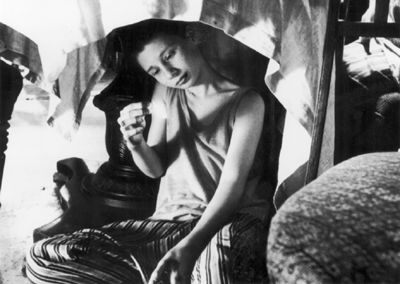    |    |
|
Last year, Russia produced one big-budget movie, Nikita Mikhalkov's The Barber of Siberia, which, in keeping with the director's unbridled ego, is being promoted for wider distribution. Accordingly, most films shown at MoMA were standard festival fare, the kind that tour the world on the circuit far away from even the patrons of art theaters. Unlike in previous years (all right, so I'm rolling together this show with other Russian-film museum presentations), nothing I have seen at MoMA is likely to match the art-house success of The Thief or The Brother -- films that successfully straddled the gap. The situation was not improved by the erratic delivery of films that played havoc with the schedule.
The opening-night teaser for the Fest was Alexei Gherman's Khrustaliov, My Car! Seven years in the making, repeatedly bailed out by French money, it was presented at Cannes last year and distributed in France. Gherman is a smart director who made only five films in the last thirty years, and fully qualifies as a cult director par excellence. While he places the blame for the scarceness of his output squarely on the Party censors, one should keep in mind that his father was, after all, a phenomenally successful writer of KGB-lauding thrillers who may have been on their payroll, and the son had inherited not only the connections but the verve in dealing with the system.
I attended a screening of one of his films, My Friend Ivan Lapshin, in Paris a few years ago, and could not help admiring his consummate gamesmanship in handling the highbrow French critics. He seemed to know exactly when to tilt slightly to the left and put in a nice word for Socialism, when to tilt to the right and poke fun at the KGB; when to acclaim the hosts' post-existentialist hangups and when to appeal to your Average Jean D'Oe and insist blithely that there's nothing complicated about his films. It was a command performance. Due to sickness, he did not show up at the MoMA screening, but instead had a very striking woman read his letter, which was another exercise in courteous epistolary writing. Off the bat: I was not impressed by any of Mr.Gherman's previous efforts. Allegedly, it was their politics that kept his work shelved. All right, so perhaps his bad guys were a dash more human and his good guys were a tad more flawed than those of his domestic competition -- a minor show of independence domestically, a footnote to the Slavic department Ph.D.'s. Again, whatever artistic achievement is claimed for his films, it is valid only in comparison to the rest of the Soviet ones, most of which were slapdash efforts. Stylistically, Ivan Lapshin is a compendium of the French nouvelle vague defrosted in the middle of Russian winter. It seems to have been directed by someone who was floored by the first ten minutes of any early Truffaut movie and never recovered. Nonetheless, I'm an optimistic sort, and was awaiting Khrustalyov, My Car! eagerly. I guess I'm just not enough of a stoic to resist the spin. Alas, my hopes were dashed. After the first ten minutes, I realized that Mr. Gherman had simply changed his main influence -- from Truffaut to Peter Greenaway (The Cook, the Thief, etc.). To be fair, he also drew on the alternate Russian tradition of "carnival" in literature, or, to be more democratic, something called "kapustnik", where characters improvise wildly, to the extent where the object of satire is safely submerged under the pile of riffs. In certain situations, kept on a short leash, the technique can be amusing, as in Sergey Solovyov's Red Rose Stands for Love, Yellow Rose Stands for Sadness, a broad satire of the Soviet life on the eve of the fall. But Gherman has something much loftier on his mind, and the result is an unmitigated disaster two and a half hours long. For a good hour, not even many Russians would make sense of Khrustalyov, My Car! without a press-release description. The time is 1953, and Stalin is implementing the Doctors' Plot, meant to usher in Holocaust Two, this time for the Soviet Jewry . Somewhere in wintry Moscow, a universally adored doctor, a general of medical service, and director of an Army clinic, glides through his clinic and his apartment, guzzling cognac and bestowing kisses and bon mots. And that is all that we see: an hour-and-half of black-and-white chaos. So convinced is Gherman of his cine-power, so dismissive of the viewer -- every frame is strewn by objects obstructing the view of faces, every face is a mask, every line of dialogue an obscure reference to… uh, I'm not sure -- one wants to escape to Disney. A hardy viewer was rewarded, sort of. Eventually, our dashing character decides he is about to be arrested, too, and walks out on his life of glamor. In short order, he is caught, thrown into a van, brutally raped by convicts, then magically released by Beria himself, who takes him to Stalin's deathbed in a last-ditch to revive the dictator. The general returns home, realizes there is no return to his former life, and has a fatal car accident. In the closing scene (typically, the accident was staged), we see him as a Russian hobo in an open railroad car. That's it? For that, shall we say, less-than-profound insight into human condition, we had to endure almost 100 minutes of washed-out images and incomprehensible dialogue plus two minutes of the most graphic, vile rape I have ever seen on film (people were turning away from the screen right and left)? Looking through the exalted raves of Khrustalyov, My Car!, I noted that most of them are written in a highly academic, conceptualized tone, drawing parallels with Kafka, Becket, Joyce, Rosanov -- and considered dialogue, plot, acting, and camerawork as unimportant. What is important, then, is the philosophy, the concept. I could not help drawing parallel with modern American art, where RISDI and CalArts train students less to create art than philosophize about it. From a purely utilitarian perspective, the difference is this: a picture (sorry: artwork) you can make snap judgment of, but the film takes -- did I mention that? -- two and a half hours. If we wanted to get away from Disney, Khrustalyov, My Car! is as good a place to be as any. But Gherman is throwing out the clarity -- the baby -- together with the bathwater of commercialism. That's a shame; clarity is perhaps the only requirement valid for both good art and a full life.
|
